Most gardeners have a deep seeded (no pun intended) desire to have an attractive landscape so managing pests without harming our beneficial insects can be a challenge. Every conscientious gardener should be aware of which insects are beneficial and do our best to protect them. Let’s consider a few of the top strategies for helping our beneficial insect population thrive.
- Diversify, diversify, diversify! The days of having 70-90% of the landscape being lawn grass should be long gone. Just to be clear, I am not advocating for totally getting rid of your lawn grass. I will remind you lawn grass does prevent erosion, provide a cooling effect in the landscape and supply oxygen. What I am advocating is to have tons of other plants which produce flowers such as perennials, shrubs, ground cover, as well as small and large trees.
- When you do select a plant – let’s say a perennial, think quantity. Consider planting 13 gaillardia, 5 African iris, 3 prostrate rosemary, etc. Give the bees and butterflies a reason to visit your yard because they can get their fill of nectar at one visit. Clustering large groups of flowering plants is much more attractive to the pollinators, hummingbirds and birds.
- Plan your site to have plants flowering all year. With the last two winters being so warm, I have seen active native pollinators even in the northeast part of Florida. Because I have wildflowers and some flowering shrubs my landscape had some tempting food sources for them.
- Remember to create layers for your wildlife, which would incorporate ground covers, then perennials followed by small shrubs and trees. This will encourage these important visitors to build their home and/or nest on your site too.
- When possible, talk to your neighbors about joining your yards and developing wildlife corridors or safe havens for native pollinators and birds. The larger the area of plants, the more opportunities for wildlife, beneficial insects and birds to survive.
- For those important native bee pollinators it is good to have a water source to provide a place of refreshment. Leave a small few patches in the lawn or landscape which contain just sand so these important bees can use the sand to build nesting tubes.
So let’s talk about the most difficult factor in protecting our important beneficial insects. It is critical to reduce or eliminate the use of pesticides in the landscape – especially pesticides in the broad spectrum category. Broad spectrum pesticide classification means the active ingredient in the pesticide has a wide range of insects it kills or controls. Some examples of broad spectrum insecticides include organophosphates (malathion), carbamates (carbaryl), pyrethroids (beta-cyfluthrin or fenpropathrin), and foliar-applied neonicotinoids (imidacloprid or acetamiprid).
If you must use a product with these active ingredients then is it best to use it in liquid form with a lower residual effect. This means we want the product to stay on the plant a very short period of time. In addition, using liquid instead of powder will help reduce the chance of bees or other pollinators collecting it in place of pollen and taking it back to the hive.
I applaud any of you who use no insecticides in your yard – kudos to you. Not applying any insecticides is ideal for protecting beneficial insects and it is a viable gardening practice but few of us do it. You may be thinking you do not use any insecticides because you do not apply those listed above, but I need to point out even “soft” pesticides can cause harm to some pollinators. When I say “soft” pesticides I am talking about products such as insecticidal soap or horticulture oil.
Insecticidal soaps have been shown to be a low potential hazard to beneficial insects such as predatory mites, parasitoids, and general predators but can be moderately harmful to bees. Therefore, if horticulture oil is needed then it is best to apply it when bee activity is low such as late evening, night or early morning.
Another commonly used “soft” pesticide is insecticidal soap. This actually has a low potential hazard to our beneficial insect friends and bees. Therefore, unlike horticulture oil, we are not limited to the application time of day. However, there is an exception; we generally do not recommend applying either the horticulture oil or insecticidal soaps in the middle of the day with the potential for intense sunlight. Applying these pesticides in direct sunlight and/or high temperatures can cause damage to the plants.
I have given you some things to think about and I know all of us can incorporate several of these into our gardening practices. Consider each time you add another strategy you will become the conscientious gardener I know we all to be and have for a neighbor!
Top 10 beneficial insects:

1. Hoverfly:
One of the colorful and common little flies in Florida. Can hover or fly backward, adults are considered important agents in the cross pollination of some plants. The larvae are important predators, feeding primarily on aphids that attack citrus, subtropical fruit trees, grains, corn, alfalfa, cotton, grapes, lettuce and other vegetables,ornamentals, and many wild plants. When larval populations are high they may reduce aphid populations by 70 to 100%. http://edis.ifas.ufl.edu/in342
 2. Predatory Stink Bug:
2. Predatory Stink Bug:
This stink bugs preys on the beetle and moth larvae of soybeans, peanuts, alfalfa, and corn. It eats the larvae of the Mexican bean beetle, the alfalfa weevil, and at least one lepidopterous species, Eurema nicippe and potentially the cabbage and soybean looper. There are several such as the Florida predatory stink bug, giant strong-nosed stink bug, and the spined soldier bug.

3. Alligatorweed Flea Beetle:
The alligatorweed flea beetle was the first insect ever studied for biological control alligatorweed. Alligatorweed flea beetles kill the plant by destroying its stored food and interfering with photosynthesis by removing leaf tissue. Both adults and larvae feed on the leaves of alligatorweed, often defoliating the stems. http://edis.ifas.ufl.edu/in831
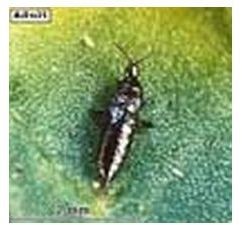
4. Alligatorweed Thrips:
The second South American natural enemy of this aquatic weed imported into the United States to control alligatorweed. Thrips damage is restricted primarily to new growth, e.g., leaf buds, new leaves, and young flowers and feed only on alligatorweed. Of the three insects (thrips, flea beetle, and moth) released for biological control of alligatorweed, the thrips is the most cold tolerant. http://edis.ifas.ufl.edu/in859
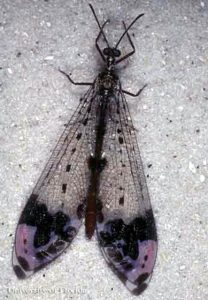

5. Antlion:
Antlions are common, conspicuous insects in Florida. Both adults and larvae are predators and are economically beneficial. Adults commonly feed on caterpillars and aphids, whereas the larvae feed on surface dwellers such as ants and other insect larvae. Photo on the right is the larvae of the antlion often called “doodlebug” by children. http://edis.ifas.ufl.edu/in708
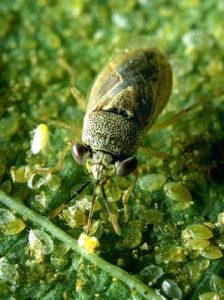
6. Bigeyed bugs:
Small insects occurring in many parts of the world. They are generally regarded as beneficial because they prey upon numerous kinds of insect and mite pests of turf, ornamental and agricultural crops.
http://edis.ifas.ufl.edu/in517

7. Brown lacewings:
Small to medium-sized insects are predaceous both as adults and larvae. They prefer soft-bodied insects such as aphids, mealybugs, and also insect eggs. They are found throughout North Florida.
http://edis.ifas.ufl.edu/in382
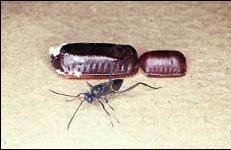
8. Imported ensign wasp:
Adult wasps are occasionally seen in city buildings and homes. The earliest U.S. record of this probably oriental species is a specimen captured in Washington, D.C. June 5, 1879. They are known to attack household cockroach egg cases. http://edis.ifas.ufl.edu/in319
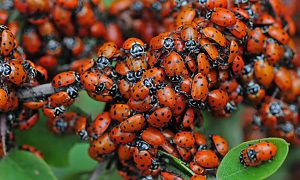
9. Convergent Lady Beetle:
The most common lady beetle species throughout North America and is an important natural enemy of aphids, scales, thrips, and other soft-bodied insects. It will also feed on pollen and nectar from flowers when prey is scarce. This species can be found in habitats ranging from grasslands, forests, agricultural fields, gardens, and natural parks. It is one of the few natural enemies currently wild-collected from mass aggregations for distribution to the pest control industry.
http://edis.ifas.ufl.edu/in1037

10. Tiger Beetles:
Are found in sandy open habitats, including river sandbars, ocean beaches, mudflats, dunes, rocky outcroppings, and even along woodland paths. As their name implies these are active, agile insects, quick to take flight, possessing good vision, and in many cases, having colorful patterns that are quite attractive. It is common to collect adult beetles with ant heads still attached to a variety of appendages! Rather than specializing on certain species for prey, adults are opportunistic feeders.
http://edis.ifas.ufl.edu/in131
 0
0
